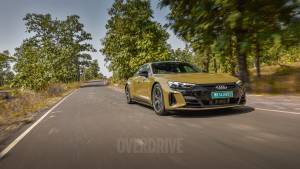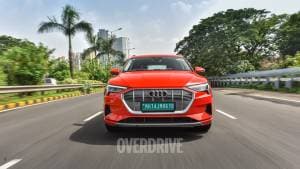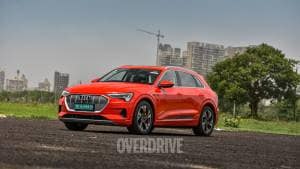Electrifying Ladakh with the Audi e-tron
Setting The Plan In Motion
As far as ambitions go, the plan to drive an electric vehicle from Delhi all the way to Leh is pretty much the biggest we've stumbled into! The grandeur of the plan however stemmed not from driving an EV to Leh, the bigger task came much later, days after we had got into conversations with Audi India about undertaking this project. Audi has always been encouraging, and over the last 8 years they have supported us in every journey that seemed almost impossible at first, but always turned out successful. They've had more faith is our abilities to execute a project when sometimes even we thought we'd chewed off more than we could bite! So without breaking into a sweat, they confirmed that we could do this activity with the e-tron 55!
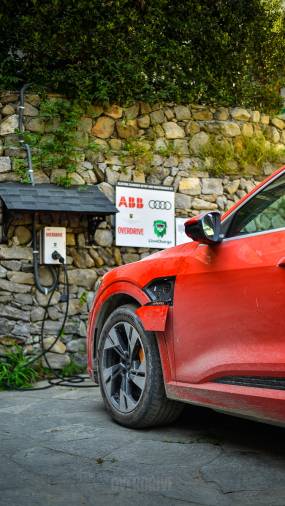
At Audi's suggestion, we also brought the conversation to the ABB table. One of the largest electric charging infrastructure providers in the world, ABB already had an extensive EV charging network in place across India. However, the highway to Leh was still untapped for EVs. There were no chargers installed anywhere along that route, and that became the pivot for the way ahead. ABB was quick to realise the potential of this undertaking and signed up faster than you could read this statement. They also brought on LionCharge who setups the infra and builds and supports the network. With all partners on board, the actual work for the drive began. And so the project took on a new dimension. We would not just drive all the way up to Leh, we would also setup a fast charging network along the route. Work on setting up the chargers began almost 2 months before the drive commenced. Saiveer who founded LionCharge set off by himself to recce the route and identify potential locations where the chargers could be setup. Finally, after 2 trips from Chandigarh to Leh and back, LionCharge setup charging points at the Patyal filling station near Mandi, the Himalayan Spa and Resort in Manali, Padma Lodge at Jispa, Sonam dhaba in Pang and finally at the Fortune resort in Spituk (Farka) on the outskirts of Leh.
The intent right from the word go was clear with clearly defined objectives. We had to avoid carrying a diesel generator to power the car, the journey had to be made within a stipulated number of days and the car had to, it just had to get to Leh and get back to Delhi! Damn, this was going to be hard. Then there was the larger challenge, of setting up a charging infrastructure all along the way to enable future EV owners to make this journey as well.
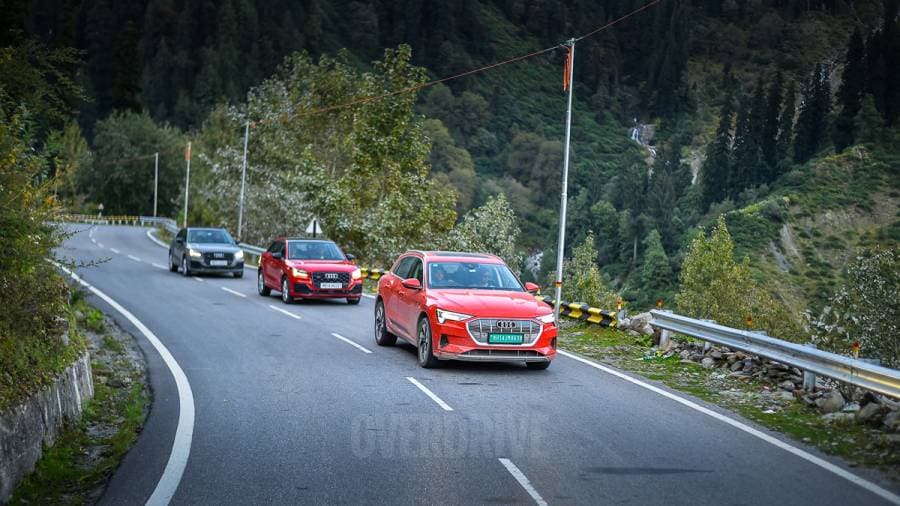
Calculating The Details
The initial days were hard. While the e-tron was confirmed, the route more or less tied down as well, it was the distances between locations where we would set up that was getting to be a challenge. You see, we had no time for a recce, and everything would have to be executed based purely on calculated assumptions. The e-tron 55 has the largest battery pack as compared to any EV available in India. 95kWh, that's how much charge the e-tron holds, and as pr WLTP cycles it could provide a range anywhere in between 350-485 kilometres. However on various EVs we have tested, real-world figures see at the very least a 15-20 per cent dip in range. That means we would have around 300-420km available to us, if we were driving in urban and extra-urban conditions. Still seems like a good number to work around with.
Then we looked back at the kind of efficiency figures the ICE vehicles have provided us in the past. On most drives, we got efficiency between 5-8kmpl climbing up to Leh, and this increased marginally until we were back in Manali where the air-fuel mixtures came back to normal. We would not have the air-fuel ratio to contend with, however, we had gradients to manage. The highway to Leh from Manali is constantly winding uphill. Chandigarh where the real journey would begin is located at an altitude of, at maximum, 360 metres (1200 feet) above sea level. Leh is at an altitude of around 3500 metres (11428 feet) above sea level. We would be climbing to an altitude ten times higher. In between, there were the high mountain passes, four of them specifically. Starting with Baralacha La at 4850 metres (16040 feet), followed by Nakee La at 4769 metres (15647 feet), Lachalung La at 5059 metres (16598 feet) and finally the highest mountain pass on this route, the Tanglang La at 5328 metres (17480 feet).
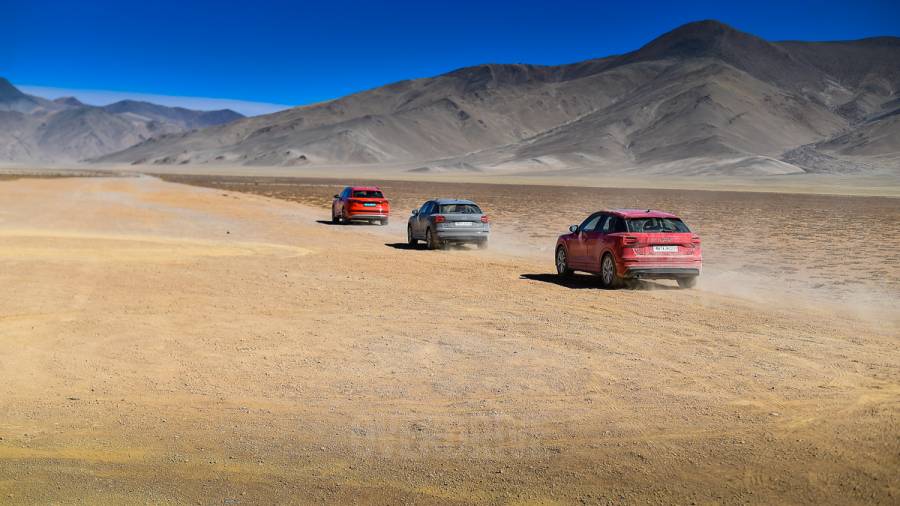
In between these there are the long stretches that ride across the Sarchu and More plains, open flatlands where the road stretches in a straight line for kilometres on end. The road length across the Sarchu plains extends for nearly 50 kilometres, while the flatlands of More plains sees the road extend similarly for around 51 kilometres. Both these are flat sections of road, marred by a few blind dips and a complete lack of habitation. This section of the highway is busy, and by that I mean you'd see a constant stream of road trippers and construction trucks heading either way between Manali and Leh, but with well-spaced intervals. So you're still on a pretty desolate stretch of road that does not choke your flow.
You can easily hold an average speed of around 60kph on these stretches. That is fantastic for ICE vehicles, but for an electric, that is a challenge, because you're constantly on the throttle, and even a 10 per cent input on the pedal drops your range rapidly. So, we stood to juice climbing up the passes, or even down the straights.
Another theory we had to account for was the lack of air at that altitude. You see as you climb higher, the air gets thinner, which technically means less drag and therefore better efficiency. However on the flip side, due to the drive taking place so close to the winter months, meant the wind would have picked up and that would increase resistance. Two sides to a coin, and there was no accounting for what would affect us more.
Then there was the human element, we also needed locations where we could park up for the night, get a hot meal and beds to catch a few winks in between the driving. Having based ourselves on historic data we had accumulated, we decided to make Mandi, Manali, Jispa, Pang and finally Leh the points where we would set up our charging stations so we could charge our car.
The Equipment
As I mentioned earlier thanks to a long-standing partnership with Audi India for these adventures and the fact that they had the only electric vehicle in India with the largest battery pack and range, made our work simple for us.
The Audi e-tron 55 has a 95kWh battery pack, powering two electric motors, one over each axle. Maximum output is rated at 402 horsepower with 600Nm of torque. The battery management system offers a choice of multiple drive modes spread between efficiency to dynamic. Each drive mode will bring into play either or both motors, however, there is also one more drive mode the e-tron offers called the range mode. Ideally to be used when you feel your car is low on range, this mode switches off certain convenience features like the air-conditioning, seat ventilation and even limits your speed to 90kph. So you have to opt for both efficiency mode, which also reduces ground clearance to reduce drag as well as keep the e-tron in range mode to avoid the heater sapping an enormous amount of charge. Switching on the heater sucked out almost 70-80km of range from the battery, no-brainer then, heating was not an option on this drive, and that is how we drove the e-tron at all times.
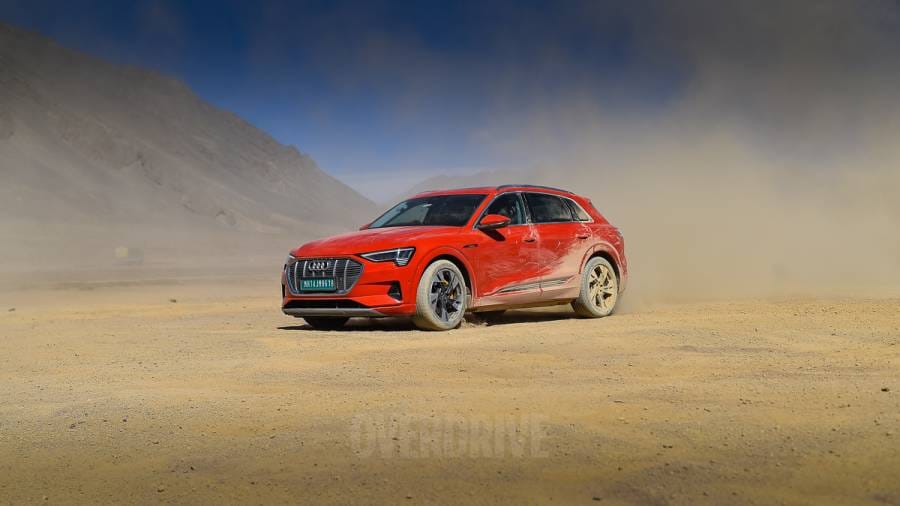
The e-tron also comes equipped with massive 255/50 R20 tyres, which place a very large contact patch on the road. Resisting that friction causes a further depletion of charge, so the idea was also to keep the momentum consistent with fewer stops. The one advantage with stop-go conditions is that every time you know you have to stop, you simply press the 'P' parking button which immediately disengages the motors and restricts it from drawing any charge from the battery.
The Audi e-tron also gives you two regenerative modes, engaged or disengaged by using the paddle shifters behind the steering wheel. These come in very handy while driving as they begin charging the battery the instant you lift your foot off the throttle pedal completely. They also provide adequate braking power without making the e-tron feel too jerky. This comes in pretty handy on the downhill sections and when you're entering a corner, though applying enough braking action will further boost charging using the brake energy recuperation system.
The e-tron also gets two charging ports placed on either side of the car. Over the left fender, you have a J1772 connector to plug into AC chargers, while over the right fender you have a DC charger compatible CCS connector. That meant we could use either port depending on the availability of charging systems. We also carried the home charging unit that Audi provides with every car as a complementary gesture. It has a three-point connector that can be plugged into any home socket and allows the car to be charged at a steady 11kWh. However, you need a larger 15 Amp American type flat pin socket to insert the connector. Audi also provides a failsafe in the e-tron, as in, it wont charge if the power outlet is not ground.
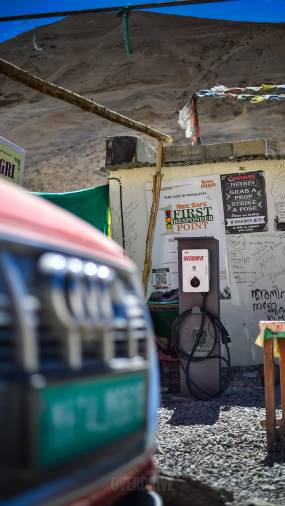
The charging setup we had placed all along our route were Type 2 AC boxes that have a rated output of 22kW. Since this is a AC charger they use the J1772 connector. The e-tron however in its present state is capped to accept only 11kW from an AC unit like most other EVs. Future updates however will allow the next generation of EVs to accept up to 22kW from AC chargers. Which means a car like the e-tron can get a full charge from nil within four and a half hours. These charging boxes use a sim card to allow you to identify the location of the charger as well as book your charge. The process is fairly simple and provided you the region has network, it works without a fuss. The chargers also control the system for voltage fluctuations, so if the voltage drops below 200V the charger wont operate. This is a major concern in rural areas where there are consistent voltage fluctuations, especially during the night. We did face a few issues with these and it literally gave us sleepless nights, we would actually stay up and begin the charging process every time the voltage stabilised.
In between Delhi and Chandigarh, as well as for one night in Chandigarh we got a proper high-speed DC unit to charge the car from. Power outputs were at 50kW and 60kW respectively, and in both these paces, the e-tron charged up its batteries to a 100 percent from as low as 20 percent within an hour and a half.
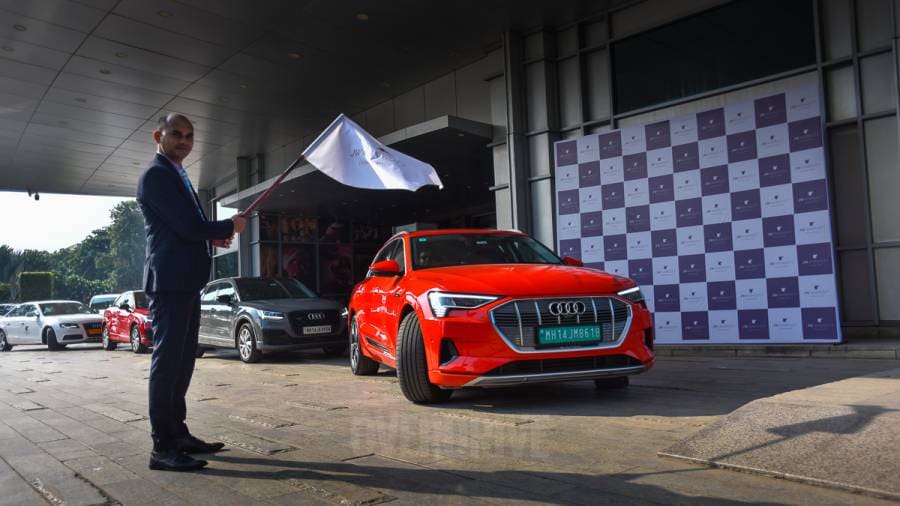
The Drive
Our journey while technically was supposed to begin from Chandigarh, began in reality from Delhi where we collected the e-tron and the support Q2s from the Audi workshop near Faridabad. On a full charge the e-tron showed us a range of around 435km. This seems like a good number to begin with, but we lost almost 40 percent of that charge just taking the Eastern peripheral expressway to get onto NH44 to Karnal. This is as I mentioned earlier is because on an open highway with sparse traffic, you are constantly discharging the battery with little hope to recuperate any charge even if you're giving just about 10 percent throttle input. However with traffic building up on NH44 and with enough stop go opportunities to brake and recuperate charge we made it to the Statiq high speed charger at Savoy Greens in Karnal. The total distance between these two points is around 190kms but by our consumption patterns the e-tron had used up a range of nearly 340 kms leaving us with a range of around 80kms till the battery ran dry.
With a 50kW output, we were able to recover almost 50% charge in just under an hour, the time we spent getting a hot meal and refreshments from the food court. Onward to Chandigarh we were a little better off, as stop go traffic increased, enabling us to recuperate a lot more charge. So by the time we got to Chandigarh, a distance of less than 120km, we had a little over 50 percent charge left in the battery with a 250 plus km range left in the bank! On the odometer, the short term memory showed us a consumption rate of 4.1km/kWh which meant rather than the 435km we would have actually got a range of only 390km since we left Delhi.
The first challenge came up at Chandigarh. At the Audi dealership we had substantial voltage fluctuations as a result of which the 11kWh chargers wont operate to protect the batteries in an EV. The minimum voltage required to charge the e-tron is 200V, and this only stabilised sometime early in the morning hours. Our departure time from Chandigarh was scheduled for around 8am, but our car only began charging at around 5am, which meant in the 3 hours we were only able to get just around 30 percent charge which increased our range to a little over 330kms. Would that be enough to cover the distance to Mandi where we had setup the next charger? I had my doubts since we would be inching our way to higher altitudes. As you climb higher, there is more throttle you need to apply, and this depletes the battery faster than when you're driving on a highway. As per plan, we would consume more and I feared range anxiety would creep in substantially. And it did hit us pretty badly very quickly into the journey.
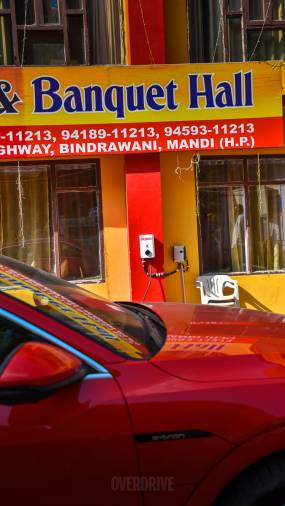
There are two routes to Manali from Chandigarh. With around 80% charge in the battery, and a range of around 330kms we were flagged ff from the J W Mariott Chandigarh. We decided to forego the route via Una which is roughly around 70kms longer than the Bilaspur highway. However we would also be giving up the opportunity to charge at Una where a DC fast charger has been setup. Instead, choosing to take the shorter route we hoped that we would be comfortable enough getting to the Patyal filling station, an IOCL fuel pump where we had setup our first charger. Unfortunately we were still in the learning process of how to drive the e-tron. And not exactly knowing how and when to use the recuperative modes, how much braking effort to employ and which modes to drive in ideally, saw us dump battery charge down to almost 50 percent just a few kilometres after hitting Bilaspur. We were now out of our depths, fear set in, that we wouldn't complete the 206km distance to Mandi. Our average speed dropped to around 30kph, we'd switched off the air-con and all electronics and opportunities to recuperate energy were few and far between. Closer to Mandi the energy bar on the right side of the instrumentation turned red, and our range dropped to under 100kms. And to make matters worse, just a few hundred metres short of the Patyal petrol pump, ongoing road works to expand this highway, had caused a massive jam. So rather than try and crawl, we decided to pullover and wait for it to clear. An hour later as traffic began rolling again, we joined the stream and rolled into the fuel station. Our leftover range was 33kms and battery charge almost down to 0! In hindsight, had we got a pick-me up at the DC charger at Una, our state would probably not have been as perilous.
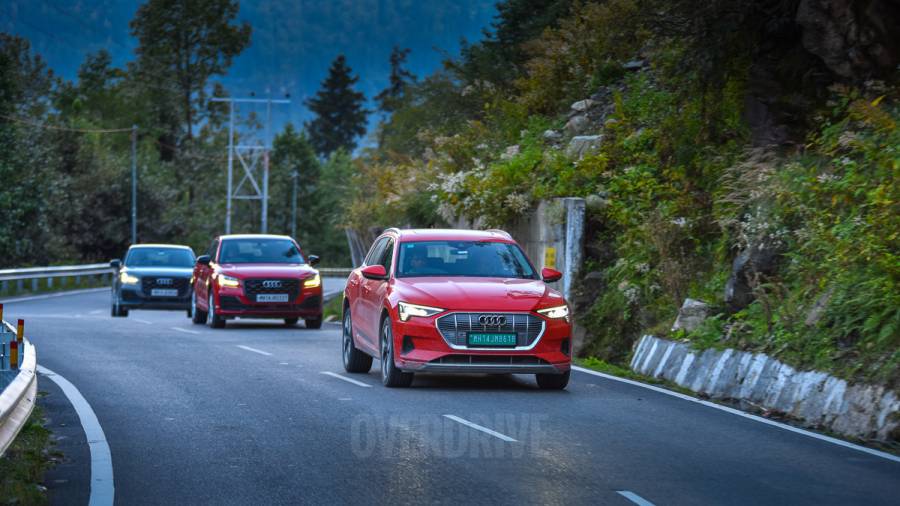
Our woes however did not end despite plugging the e-tron into in the charger. Just a few moments later as we breathed a sigh of relief on seeing the charging light glow green, the power went out! Apparently construction workers on the highway expansion job had uprooted a power line close by, disrupting power supply to the entire region. We were told it would take at least 5 hours for the power to resume. By now it was 2pm in the afternoon, so we'd get back power to begin charging our e-tron by 7pm, add another 4 hours to get around 50 percent charge back into the system, then another 4 hours to drive to Manali which meant we would hopefully, be in bed, no sooner than 3am! And that is exactly what happened. Once power resumed, it was seamless and the e-tron rapidly juiced up. In just a little over 4 hours we had managed to pump in a little over 50 percent charge in the battery after which we set off. By now we assumed traffic would have thinned out but the construction works near the Kullu tunnel saw us crawling through dense truck traffic. We began losing charge again. But soon thereafter the roads opened up, the roads got smoother, there were more corners and traffic reduced to almost nothing so I applied a new trick to regain charge. I shifted it into dynamic mode and whipped up the horses. Dialling more throttle, allowing for more coasting, braking later and harder into corners recharged the battery quicker. This is however not something you can do for long distances. This works in short bursts, and helps you recover some charge while also covering a little more ground, though the loss is equitable to what you gain. Had I kept it paced steadily, I would have only discharged the battery without recovering anything at all. Net effect was that I made it to Manali with almost 30 percent charge in reserve and a range of almost a 120 odd kilometres still to go.
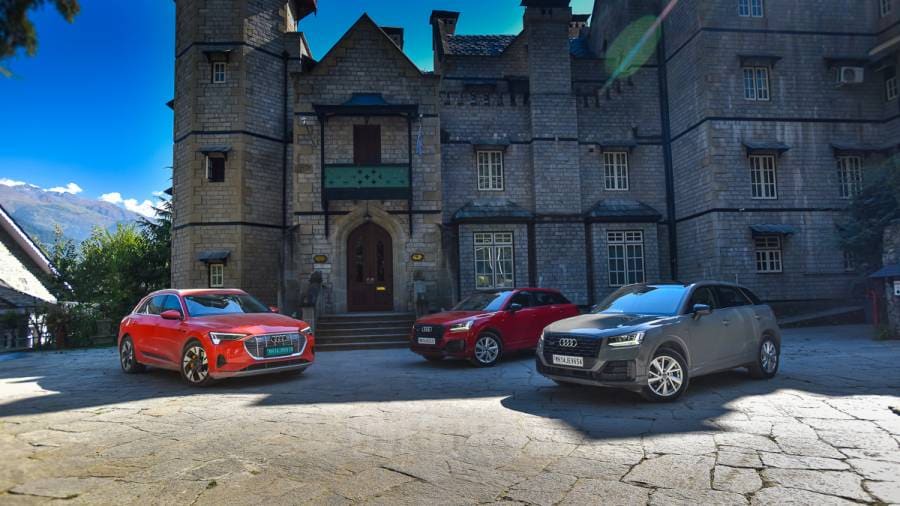
At Manali we had setup the ABB charger at The Himalayan Spa and Resort, a lovely gothic styled castle with quaint architecture quite unlike anything you'd see in this region. This was the most seamless charge experience we had, but by that I mean it had the least interruptions where voltage was concerned. Once during the middle of the night, the charger switched off, and this got Saiveer running down in the wee hours of the morning to get the car charging again.
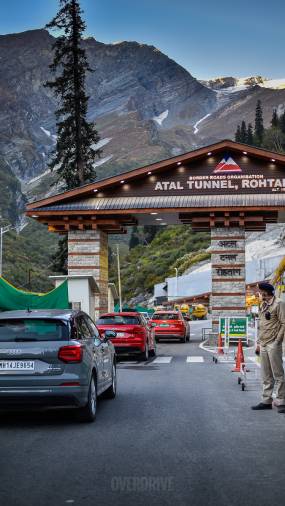
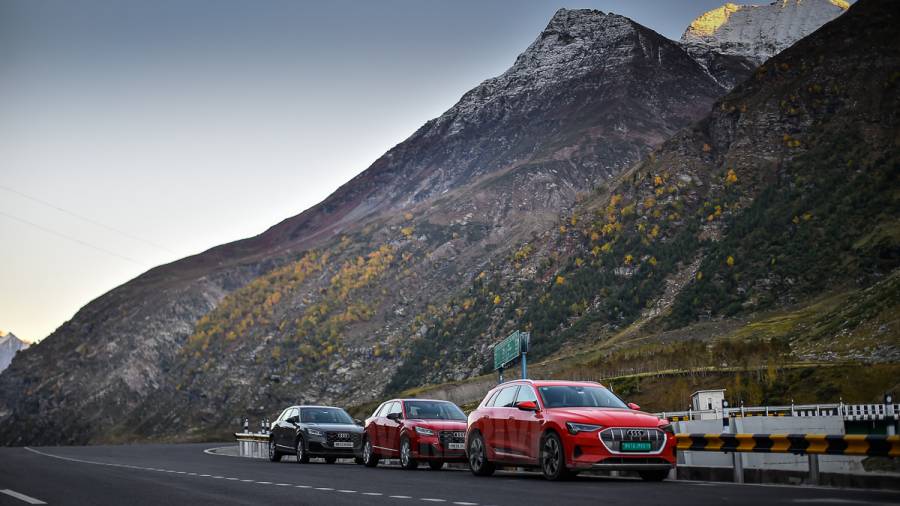
A very late start from Manali the next day, well post lunch, saw us head off towards Jispa with a full charge and a range of almost 400kms on the meter. Fortunately we wouldn't be climbing up the formidable Rohtang pass, instead the Atal tunnel proved to be a life saver cutting the distance and elevation we would traverse to a negligible amount. The roads also leading into the Spiti valley are fabulous, smooth, unruffled, ideal conditions to drive even a super car on. But that does not work for the e-tron because you need areas where you can use the brakes. Nonetheless with elevation changes the e-tron was still able to hold a substantial amount of charge. By the time we reached Jispa we had lost just around 30 percent of charge and the range showed us upwards of 250kms. In fact at Tandi just a few kilometres before Jispa, it's the first time ever, I've not had a reason to stop at the fuel pump here that is famous for a sign board that reads 'next filling station 365kms ahead!'
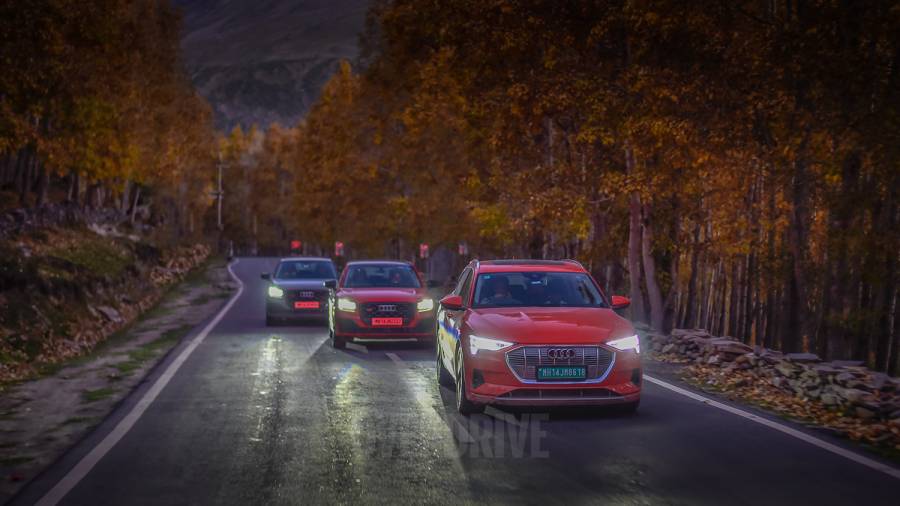
We arrived at the Padma lodge in Jispa where we had setup the next ABB charger well past sundown. Jispa was a bit of a sore point, because the voltage kept fluctuating, and we had to sit patiently with the car for a few hours. Nonetheless by midnight the voltage had stabilised and we had a full battery and range slightly north of 320kms by the wee hours to traverse the toughest and one of the longest sections of the entire journey up to Leh. Next destination, Pang.
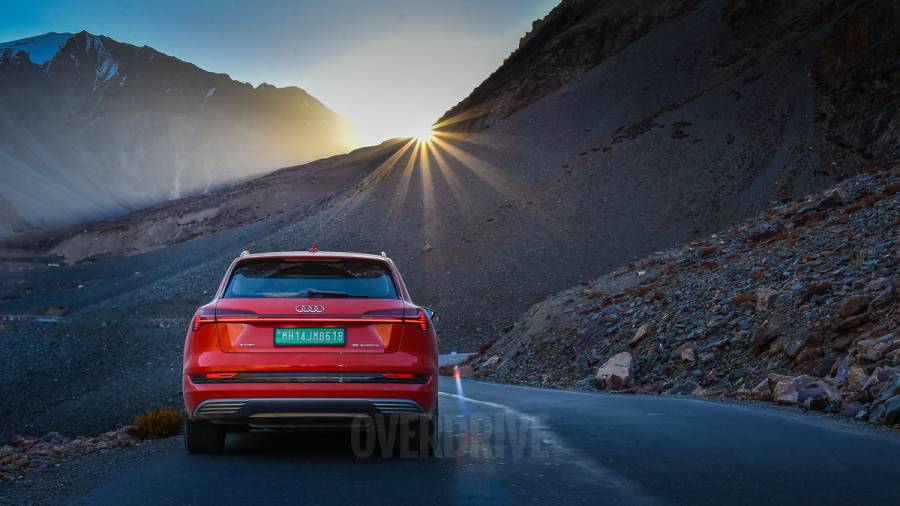
Our first big hurdle came up at Baralacha La. The pass is situated at an altitude of 16040 feet above sea level, that's almost 6000 feet higher than where we had started that morning. The roads are in superb condition, with a few opportunities to brake and recuperate energy. For this run however we had slotted the e-tron into 'Range Mode'. This switches off certain essentials, one of them primarily being the heater which saps a serious amount of charge from the battery. Our efficiency meter showed us a consumption of 2.1kw/km which isn't too bad. So we went up to Baralacha La pass with no heating when the outside ambient temperature was at its lowest, just a couple of notches below 0 degrees! That decision while cold, saved us a generous amount of charge, and the way down from the pass towards Sarchu gained us a bit more. We achieved the slight bump in charge by playing around with the recuperation system. Using the paddle shifts to toggle between level 1 and 2 recuperation enable us to get almost 3 percent charge back into the system. This also increased our range substantially. While we lost almost a 100 kms in range, we clawed back almost 40kms on the downhill sections.
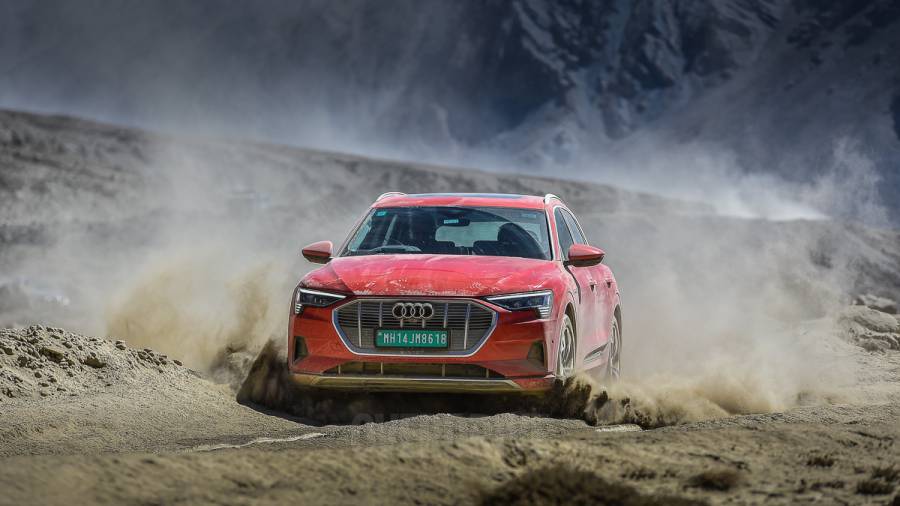

Then came the Sarchu plains. Interestingly the highway across the plains leading up to Leh has a slight downward slope. This allows you to dial in a bit of throttle, but also ease back and let the car coast for a few kilometres. So to maximise range, I'd gently throttle up to around 90kph, then let go and let the e-tron coast till speeds dropped down to 50kmph. I kept cycling through this for the next 40 odd kilometres before we hit the Gata loops, a series of 21 hairpin bends leading up to the Nakee La at 15647 feet above sea level. This section was a bit tricky for the e-tron because the going is slow, and while you brake hard enough to recuperate some energy before the bends, you lose the same amount or more past the corner where the climb is steep again. Once past the pass, the descent is short, you drop just around 2000 feet, so you don't recuperate enough energy back into the system, before you start another climb up towards Lachalung La, another pass that stands above 16000 feet. By now the charge in the batteries was down to almost 40 percent just as we drove across Lachalung La. On the other side though you get a fairly long descent that allows you to regain some energy, while the road also withers out into dirt sections with broken down tarmac. The constant braking allows you to recuperate some more charge, and by the time we got into Pang, we had almost 30 percent charge left in the battery.
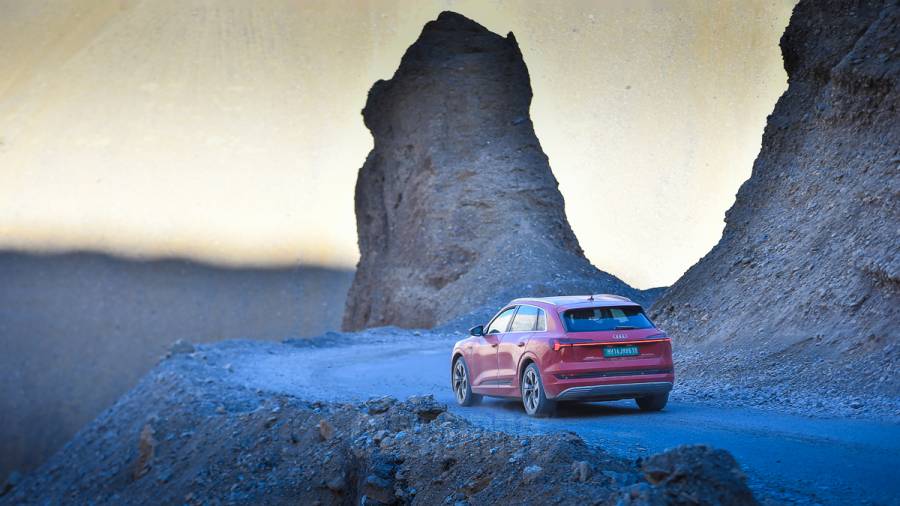
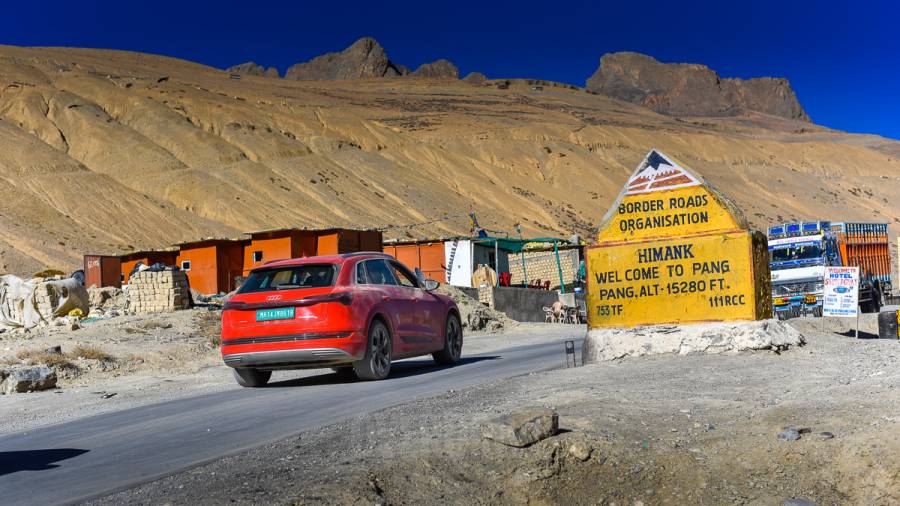
Full disclosure, Pang is the one point on this journey into Leh that does not have power supply from the grid. This place started off nearly three decades ago as a collection of makeshift parachute tents built alongside an army camp to offer weary travellers a chance to acclimatise and refresh. It's a hard place even today, the altitude and freezing wind hits you badly, and even though the parachutes have been replaced by frail, weather beaten, brick and mortar, it still feels like hell froze over. It still does not get power from the grid, because there are just around a dozen dhabas at this location. So everyone relies on diesel generators for power, and with the NGT clamping down on reducing pollution, there are just around 2-3 diesel generators providing power to the entire fraternity assembled here, and that too these are only allowed to be switched on post sundown and then too for just a few hours. So we had to resort to what we had on hand, and use the DG set owned by Sonam aunty's (as she's popularly known) dhaba. Unfortunately her DG set wasn't functioning as well as it did when we set up the charger. So charging was slow, eventually 5 hours later we had recovered just around 20 percent charge. It was dark by now, Saiveer who was monitoring the charging, got hit by the altitude and pretty soon keeping him in that place was untenable. So an hour before midnight, with around 50 percent energy in the batteries and the range showing us a 170kms we set off for Leh, 178kms away, not knowing if the e-tron would make it on its own power or we'd have to tow it into Leh.

We hit More plains in the dark, and the long undulating ribbon of tarmac was the only bit visible under the glare of our headlamps. The beauty and splendour of the More plains was invisible, so all we could do was roll along sedately, maintaining an average speed of 40kph. Every now and then the convoy would have to stop to let Sai throw up and empty his innards onto the shoulder. Fortunately More plains, like Sarchu has a slight downward slope on several sections of the 51 odd kilometres running through it. This allowed me to regen some of the power and by the time we started climbing the last pass on this journey, the once formidable now smooth as silk, Tanglang La, we had consumed just around 5 percent of charge. Tanglangla however was another beast to tame altogether. The climb up from More plains to the top pf the pass situated at 17480 feet above sea level, drained out almost 25 percent of the battery leaving us with just about 15 percent in reserve, a potential range of under 60kms with almost a 100kms left to reach Leh and a severe headache bursting though my temples. Every inch of the way up Tanglang La, my entire focus was on maximising the range, keeping a light foot on the throttle, using the paddle shifts when possible, braking whenever possible, all in the effort to get to the top of the pass. It is a bit scary watching the range on the meter tumble rapidly. When we started the climb up, it showed me around 155kms to go, by the time we hit the pass, that figure had dropped down to 60kms.
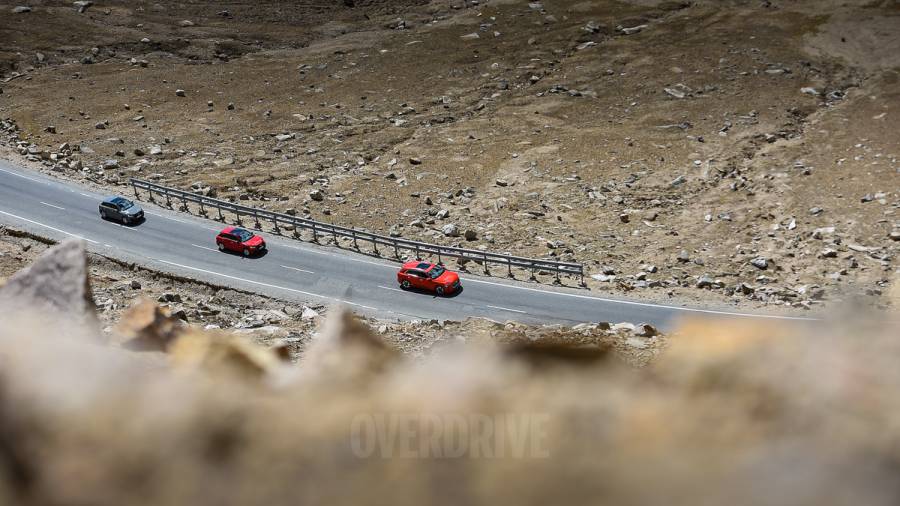
There however is a God up there, smiling down on the whole EV movement! From the top of Tanglang La, all the way down to Rumtse and right up to Karu, is a steep downward slope extending nearly 75 kilometres. We rolled down every inch of those 75 kilometres without consuming a single percent of charge. On the contrary, using the regen modes, and heavy braking on the steep descents and hairpins, we clawed back almost 10 percent battery charge, and when we touched the Karu check post, our range had extended to 210kms! There was just another 40 kilometres left to go to our last point on this journey, the Fortune Resort in Spituk, where we had installed our final charger.

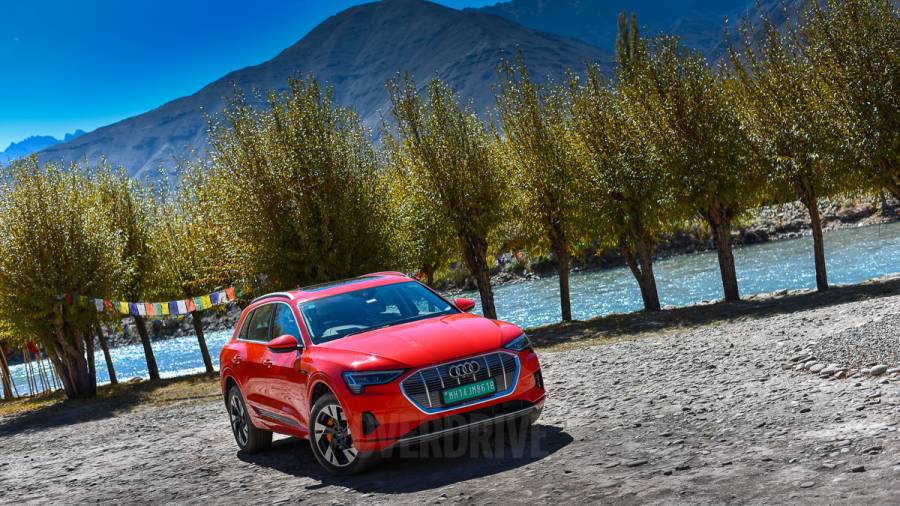
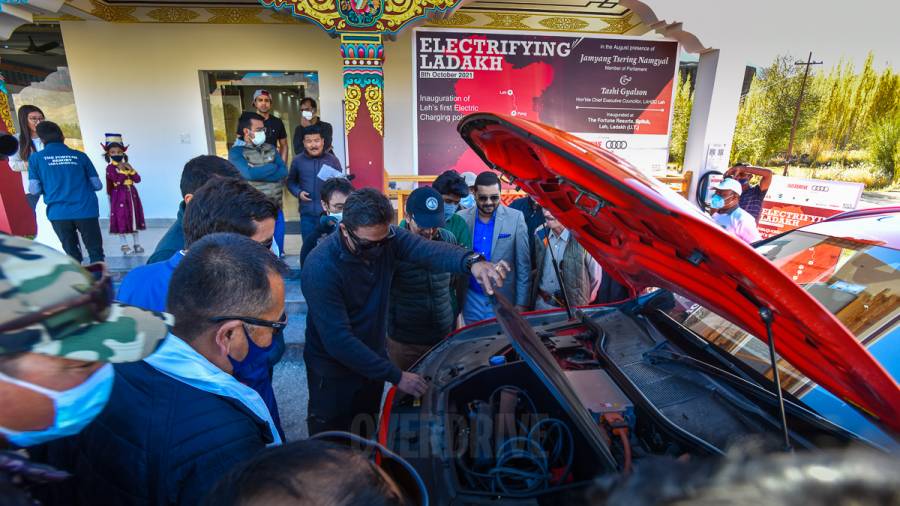
As planned, we had made it to Leh in exactly 4 days. A few hours more than it would have taken a conventional internal combustion engine vehicle to cover the same journey. Against all odds, and keeping our sanity and to a large extend our health intact (not going to count the acidity from all the stress), we had driven the Audi e-tron on an epic pioneering journey into Ladakh. We adhered to all the conventional processes, did exactly what any other traveler on this road would do, and made it in time to inaugurate our charging station in Leh at the hands of Jamyang Tsering Namgyal, Member of Parliament from the Union Territory of Ladakh and Tashi Gyalson, The Chief Executive Councillor, LAHDC, Leh.
Special thanks to http://go2ladakh.in/ for their support & assistance in Ladakh
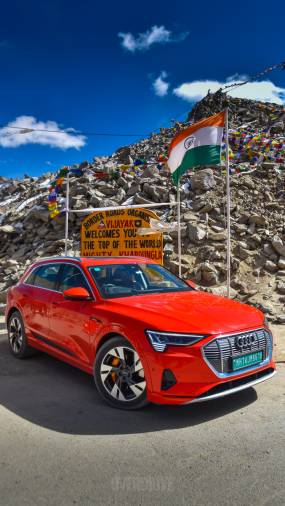
*Four days later we resumed our journey back to Delhi. We left Leh with a full 100 percent charge, and a range in excess of 420 kms. We made it back to Manali in a single day, without needing a single charge anywhere along that highway. This was only possible because on the return journey you get ample opportunities to recharge your batteries as the entire route is now a descent into Manali. Modulating throttle inputs, carefully adjusting the recuperation modes and using the brakes fully ensured we recovered almost 20 percent charge back into the e-tron's system.
** Pang, on the Manali Leh highway still remains the only location where we had to use a diesel generator to recharge the e-tron batteries. Efforts are on by his Excellency, Jamyang Tsering Namgyal, to bring power to this location. We are hopeful that, within a year or two, Pang will be added to the grid ensuring this route is a fully sustainable, 100 percent electric ready highway.
Images by Sumit Gaikwad
Also read,
OVERDRIVE inaugurates the world's highest EV charging station at 15,280 ft at Pang
2021 Audi e-tron and e-tron Sportback launched in India, prices start from Rs 99.99 lakh
2021 Audi e-tron 55 road test review
Tesla Model Y spied testing in India at OVERDRIVE charging station, launch in 2022?
Starts Rs 99.99 Lakhs
-NA-
Automatic
413
664
-NA-
